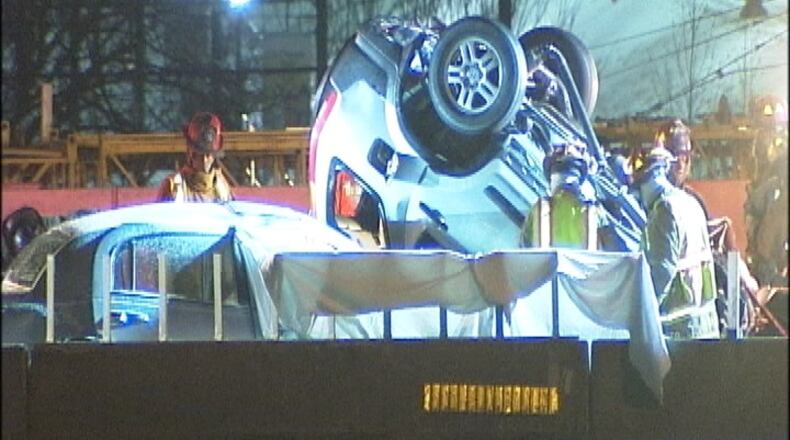“They are extremely rare, but when they occur they are catastrophic,” he said.
Ohio had planned a pilot a program to test whether its current SpeedInfo sensors along I-70 could detect wrong-way drivers and alert law enforcement. But the program was suspended when it became apparent the state’s speed cameras wouldn’t mesh technologically, Bruning said.
But this month, workers in Arizona will begin constructing a first-in-the nation system to detect wrong-way vehicles.
The $3.7 million pilot project along 15 miles of Interstate 17 will employ thermal cameras to detect wrong-way drivers on an off-ramp. The system — called TrafiSense manufactured by FLIR Systems — will trigger an illuminated wrong-way sign for the driver as well as alert authorities.
The system will also prompt messages on overhead signs to alert motorists to be on the lookout for a wrong-way driver. Additional cameras will be placed at mile intervals to help troopers plan a response, according to the Arizona Department of Transportation.
More ‘wrong way’ signs added
Deploying wrong-way detection technology at even half of Ohio’s 5,209 ramps would cost tens of millions, Bruning said.
The state, however, is not ignoring the problem, he said.
Many off ramps in urbanized areas are getting lower “wrong way” signs, as studies show impaired drivers are more likely to be looking down, according to Bruning. Some ramps in cities already have no fewer than six wrong way signs, some at three feet and others at seven feet off the ground, placed at various distances.
Traffic engineers at ODOT are also in the process of plotting DUI arrests and drinking establishments, Bruning said.
“That might help us with a best guess on where to do other countermeasures,” Bruning said.
Countermeasures can include lower signs, additional road striping and directional arrows painted on the roadway, Bruning said.
State data showed that 68 percent of fatal wrong-way crashes were alcohol-related between 2013 and 2015.
Area crashes deadly, fiery
Five people, including several local musicians, were killed in Dayton on Interstate 75 in a February 2016 wrong-way crash blamed on alcohol.
Wrong-way crashes have accounted for six fatalities — or about 1 percent — of Ohio’s 605 traffic deaths so far this year, according to preliminary ODOT statistics.
Andrew T. Brunsman, a wrong-way driver who triggered the fiery April 30 crash on Interstate 75 in Dayton, had alcohol and marijuana in his system at the time he plowed into a semi head-on and died, according to the Montgomery County Coroner’s Office.
Brunsman, 30, of Beavercreek was northbound in the southbound lanes when he hit the truck pulling a tanker of gasoline. The collision and following explosions sent fireballs skyward and plumes of black smoke pouring over Dayton neighborhoods north of downtown. The inferno damaged pavement which delayed the reopening of some lanes.
The Federal Highway Administration estimates 300-400 people are killed on average each year in wrong-way crashes, which happen usually at night and are likely to be 100 times more deadly than other collisions.
In 2016, just 30 out of 305,959 crashes in the state were caused by drivers travelling in the wrong direction on a divided highway. Of the 1,134 fatalities in 2016, wrong-way driving was blamed for 18 deaths, or 1.6 percent.
Wrong-way crashes account for a small percentage of Ohio collisions, traffic fatalities
| Year | All crashes | Wrong-way crashes | Percentage | All fatalities | Wrong-way fatalities | Percentage |
|---|---|---|---|---|---|---|
| 2005 | 358,590 | 62 | 0.02 | 1,328 | 8 | 0.60 |
| 2006 | 334,206 | 44 | 0.01 | 1,239 | 4 | 0.32 |
| 2007 | 328,742 | 27 | 0.01 | 1,257 | 10 | 0.80 |
| 2008 | 320,877 | 42 | 0.01 | 1,191 | 1 | 0.08 |
| 2009 | 298,658 | 26 | 0.01 | 1,022 | 5 | 0.49 |
| 2010 | 300,163 | 32 | 0.01 | 1,080 | 6 | 0.56 |
| 2011 | 297,831 | 37 | 0.01 | 1,016 | 6 | 0.59 |
| 2012 | 287,035 | 69 | 0.02 | 1,122 | 23 | 2.05 |
| 2013 | 269,078 | 76 | 0.03 | 990 | 11 | 1.11 |
| 2014 | 282,368 | 47 | 0.02 | 1,008 | 7 | 0.69 |
| 2015 | 302,307 | 63 | 0.02 | 1,110 | 8 | 0.72 |
| 2016 | 305,959 | 30 | 0.01 | 1,134 | 18 | 1.59 |
| *2017 | 149,508 | 12 | 0.01 | 605 | 6 | 0.99 |
*2017 data are preliminary as of July 31.
Source: Ohio Department of Transportation
A Fairfield couple died in April 2016 when a wrong-way driver struck their car on Interstate 75 in Evandale. Nazif Shteiwi, 61, and his wife, Halla Odeh Shteiwi, 55, were returning from a family function in Kentucky when hit by Kory Wilson, 30, of Springfield Twp., who also died.
Wilson had a blood-alcohol level 2.5 times the legal limit in Ohio, said Hamilton County Coroner’s Office. Witnesses said Wilson was driving the correct way on I-75 seconds before the crash, then abruptly turned around. The Shteiwis, who immigrated from Jordan 40 years ago, had four children in college when they died.
Wrong-way crashes, 2016
| County | Number |
|---|---|
| Crawford | 1 |
| Cuyahoga | 3 |
| Defiance | 1 |
| Franklin | 5 |
| Hamilton | 6 |
| Licking | 1 |
| Lucas | 1 |
| Montgomery | 3 |
| Ross | 1 |
| Summit | 4 |
| Trumbull | 2 |
| Tuscarawas | 2 |
| TOTAL | 30 |
Wrong-way crashes, 2017
| County | Number |
|---|---|
| Belmont | 1 |
| Brown | 1 |
| Clark | 1 |
| Cuyahoga | 2 |
| Lucas | 2 |
| Montgomery | 2 |
| Richland | 1 |
| Stark | 2 |
| TOTAL | 12 |
2017 data are preliminary as of July 31.
Source: Ohio Department of Transportation
No number of countermeasures may prevent a driver intent on killing themselves by hurtling into oncoming traffic, transportation officials said.
Officials ruled the March 10, 2016, death of Christy Lakins, 36, a suicide after the New Carlisle woman drove the wrong way on Interstate 70 and crashed into a semi in Clark County.
Not a year before, Christopher A. Coleman of Xenia also died in a Clark County crash ruled suicide by the coroner. Coleman, 35, crossed into the eastbound lanes of Interstate 70 and crashed head-on into a tractor trailer at Enon.
CONTINUING COVERAGE
This newspaper is committed to covering transportation and public safety issues, including analyzing trends on our highways like wrong way crashes and efforts to prevent them.
About the Author



